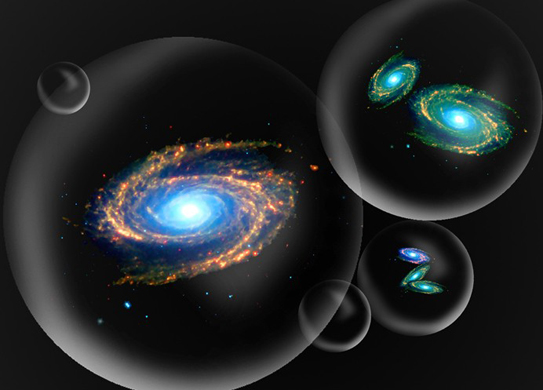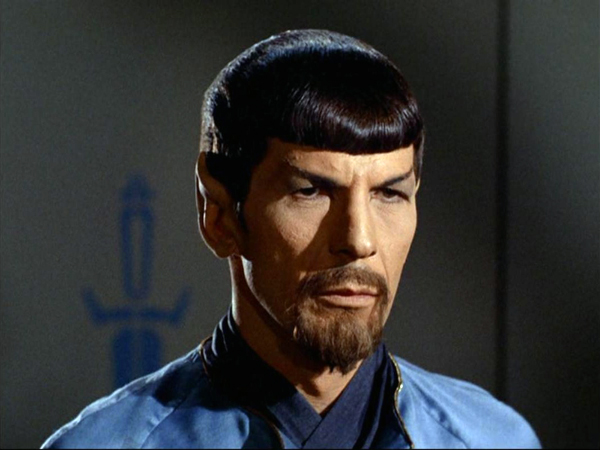Parallel Universes
What Are They? Do They Exist? How Do We Find Out?
by Larry Klaes, space exploration enthusiast, science journalist, SF aficionado. The article first appeared at Science That.
Two physicists decide to visit Las Vegas to try their luck at gambling. One of the pair plays craps, where he proceeds to rapidly lose their limited funds as he continually throws one poor roll of the dice after another. His companion, none too pleased at watching their money disappear, demands to know from his friend why he keeps playing this game despite losing every time.
“I may be losing at craps in this universe,” replies the first physicist, “but in an alternate reality, my duplicate is making a fortune!”
Among the biggest mysteries of modern cosmology is the question of whether other universes beyond our own exist in the Cosmos, or Multiverse, as it would be called should they prove to be real.
The general public is aware of the concept of parallel or alternate universes largely through popular science fiction, where they have been a plot device for a long time. Perhaps the best known of those imagined alternate existences is the Mirror Universe of the Star Trek series, where we meet the “bad” versions of the main characters from our universe – or their own fictional “reality” parallel to our real reality.
But do parallel universes truly exist? Are they composed largely of varying degrees of the people and places we know from this reality? Or could they be something far more complex and vast than most science fiction has ever attempted to portray?
If certain physicists who study this concept are correct, then parallel universes exist on a number of “flavors” or levels. Max Tegmark, a professor of physics at the Massachusetts Institute of Technology (MIT) says there are four levels of parallel universes. They range from the first level, where alternate realities exist at distances well beyond the observable Universe we live in, to the fourth, where all mathematically possible universes can and do exist. Many if not most of those universes would not resemble ours at all, obeying entirely different laws of physics. The universes envisioned by Tegmark would be virtually impossible to visit, barring some breakthrough in physics and technology.
Another type of alternate universe is known as the Many Worlds Interpretation (MWI). This theory was first proposed by Hugh Everett III in 1957 and later became the Level Three type of alternate universe in Tegmark’s catalog of parallel existences. Utilizing quantum physics, MWI claims that every action by every person and object creates an infinite number of alternative actions that branch off into their own universe. In this scenario, every possible history and future becomes reality in its own existence separate from our own. This idea was the plot device for the science fiction television series Sliders, which had a group of people travel to alternate Earths every week from 1995 to 2000 via a machine that generated a wormhole.
Could we ever detect or visit these parallel universes? If the theories of current physics are proven true, then the answer would be not any time soon in most cases. However, there has been speculation that four “cold spots” or “bruises” in the cosmic microwave background (CMB) radiation – the surviving remnant of the Big Bang which began our universe some 13.8 billion years ago – are alternate universes which either once quantum entangled with or “bumped” into our reality at some point in the distant past.
If there were parallel universes which collided with our own Universe, one has to ask why they did not create a new Big Bang as predicted by the ekyprotic cosmological model: In this scenario, a physical property in string theory called branes has the branes of several universes collide perhaps once every one trillion years or so. Their collision releases huge amounts of energy to create a new universe. This is what some scientists say is what brought about our Universe in contrast to the current Big Bang model of creation.
There are those who disavow the idea of other universe beyond our own. They correctly state that there is no scientifically empirical evidence for their existence, only theories and mathematical models. While these skeptics are correct in their reasoning, one also has to ask if they need to take another look at our perspectives on the Cosmos over the centuries. Not too many centuries ago, only a few people dared to speculate there were any worlds beyond our Earth or that the Sun was just a very close member of those myriads of twinkling stars in the night sky.
As late as 1920, astronomers were still debating whether the Milky Way galaxy was the ultimate cosmic structure or just one of many billions of stellar islands in the Universe. We now know the latter to be true, adding to our list of cosmic “demotions” from thinking we were the literal focus of existence to just being residents of a rather small world circling a typical star in a galaxy of hundreds of billions of suns, all of which is part of an immense and ancient Universe with at least one hundred billion galaxies if not more.
So are we part of a vast, singular Universe, or is our reality just one of an infinity of alternate existences on a scale far beyond what even our current knowledge can determine? Just as with the possibility of there being extraterrestrial life now that we know many billions of worlds exist in our Milky Way alone, or the historical precedent of Copernicus and others claiming that Earth is just one planet orbiting its sun and not the other way around, it is very tempting to conclude that even something as massive as the Universe might not be the only one in reality. However, we must temper our conclusions on this exciting possibility until the day science determines their existence – or lack thereof.




Very interesting article, thanks for sharing Athena! Larry Klaes writes insightfully on a variety of topics, and an even and concise discussion of the often sensationalized idea of parallel universes is very welcome.
Parallel universes have become very popular with science popularizers when dealing with the “beautiful and (currently) untestable” side of physics, no doubt because of their gee-whiz SF appeal. To me they never appeared to be much more than appealing mathematical models with not a shred of physical evidence to support their existence, perhaps not even classifying as science.
It seems I’m not so far off, as other than some vague comparisons to the steady expansion of our astronomical horizons- the pinpricks of celestial fire giving way to a vast expanse of faraway stars, and then an endless ocean of incredibly distant galaxies- there really isn’t much to back up the notion of parallel universes. At least not yet.
After all, we could always see the stars, and before we determined those odd spiral nebula were really faraway galaxies we still saw them as fuzzy objects in our telescopes. But maybe it is just easier to see science as a logical procession of discoveries in hindsight, while looking forward at the frontiers of physics we just can’t predict what new hypotheses might be advanced to explain our current observations. Maybe those “bruises” in the CMB really are the first inklings of a real multiverse.
I find the idea of other universes that obey entirely different natural laws rather appealing, actually. It would be interesting to see what other models mother nature might cook up. Most might be squibs compared to ours, considering that even a slight variation of physical constants would have made life impossible in our universe. Image tearing a hole straight into another universe predicted to be similar to ours, only to find that stars die without producing any carbon because of a slight variation in nuclear physics!! Better hope you have a return ticket.
The first time I encountered the idea of parallel universes
was probably in some Silver Age DC comic book — I remember that
Flash could “vibrate” himself into “another dimensional plane”
or some such thing; Superman had his Phantom Zone projector,
and so on. But the most memorable such early encounter for
me was a Damon Knight story called “What Rough Beast?”, originally
published in 1959 in the _Magazine of Fantasy & Science Fiction_,
reprinted in a 1960 Doubleday hardcover _The Best from Fantasy
& Science Fiction, 9th Series_ (Robert P. Mills, ed.), and which
I got my hands on when that anthology came out in 1964
in a 40-cent Ace paperback edition (F-267).
That collection also contained “Flowers for Algernon”. I read
a lot of good stuff that summer (I was 11 going on 12, the summer
between 6th and 7th grades).
“What Rough Beast?” contains a sly allusion to Christmas; now would
be a good season to re-read it. (It is far from a jolly story,
though — be warned.)
Echoing Christopher Phoenix and adding my thanks too–that was fascinating. We (meaning, human beings) want to have a way of expressing “all of creation”–but whatever boundaries we set on the all of it, there keeps on being more (or keeps on being the possibility of more). A rich and wonderful reality.
Thank you again, Athena, for posting my writing. My goal and hope is that readers will want to explore the concept further with the tidbits of information I have given as starting points. It is a fascinating concept, real or otherwise.
We might end up creating our own universes of the artificial kind. Already a simulation of the multiverse has been made in a laboratory setting:
http://sciencethat.com/?p=284
There is also speculation about artificial “baby universes”. An advanced society could snap off a piece of our Universe and make their own little universe separate from our own. Again, quite speculative, but very interesting.
A description of a natural baby universe:
http://www.ralentz.com/old/astro/hawking-2.html
Alternatively the other Universes of the Multiverse, in the Everettian sense, could be very, very distant regions of a spatially infinite Universe – all quantum possibilities should obtain somewhere in an infinite Universe. In fact Max Tegmark argues such a possibility in this paper: Born in an Infinite Universe: a Cosmological Interpretation of Quantum Mechanics, which would merge two Tegmarkian “Multiverses” into one. A similar merger of the two is argued by Yasunori Nomura: Physical Theories, Eternal Inflation, and Quantum Universe.